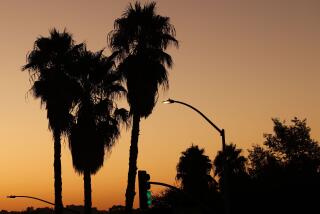As a heat wave rolls across U.S., scientists predict more to come
Climate scientists have this to say about the record-breaking heat wave rippling across the country: Get used to it.
This week’s spike toward triple-digit temperatures is unusual, they say. But as Earth gets warmer and greenhouse gases build, highs will keep getting higher.
“There have always been heat spells,” said Glen MacDonald, the director of the UCLA Institute of Environment and Sustainability, in an interview with the Los Angeles Times. “That’s just the climate system. But … if you’re generally warming things, you have a greater chance to reach new highs. Your hot spells become even hotter than they had in the past.”
According to federal climate data, dozens of heat records have fallen or been tied in the past week, and even more in the past month. In the past 30 days, the number of broken daily records climbed beyond 2,360, hitting nearly 35,000 over the past year.
The heat this week has baked an already-dry corn crop in the Midwest and South, and hampered firefighters’ efforts to battle wildfires in Colorado and elsewhere. And, officially, the summer isn’t even 2 weeks old.
One week of high temperatures is not a sign of massive global warming, said Paul Bunje, the director of UCLA’s Center for Climate Change Solutions. Weather is random, influenced by factors including the temperature of major bodies of water and the flow of air currents in the atmosphere.
“But weather phenomena like heat waves, like this one, are more likely when you look at climate change models,” Bunje said in an interview with The Times. “You see everywhere continuing to warm, and events like heat waves occurring with more frequency.”
Models showing climate trends -- an evaluation of weather patterns over time -- show that the warm season is getting longer, droughts are becoming more prevalent and minimum temperatures are rising.
“Can we say this heat wave is a smoking gun for climate change? No,” MacDonald said. “But … it’s consistent with what we would anticipate.”
The heat wave has hit certain areas of the country particularly hard, especially the Midwest, which has been battered by drought since April, the National Weather Service said. The Kansas City area typically sees 13.6 inches of rain by the end of June. That number currently stands at 5.25 inches -- 39% of normal.
“I’m not sure if it’s statistically significant,” Chris Bowman, a NWS meteorologist in Kansas City, told The Times. “We’re just in a period of pretty intense heat. It happens.”
The drought combined with blistering heat has stunted the corn crop in Kansas and other nearby states, including Missouri, Arkansas and Iowa. Bowman took a conference call with the Missouri Department of Natural Resources this week, in which he was told crops would die if they didn’t see rain or a break in 100-plus temperatures.
“You’re just baking whatever moisture is left in the soils,” Bowman said. “Things start to dry up pretty quickly.”
ALSO:
No further trial delay for Ft. Hood shooting suspect, judge rules
Geoge Zimmerman must wait: Bail hearing ends without decision
TSA fires 8 federal air marshals for drinking on job; 6 others suspended
Follow Laura on Twitter. Email: laura.nelson@latimes.com.
More to Read
Sign up for Essential California
The most important California stories and recommendations in your inbox every morning.
You may occasionally receive promotional content from the Los Angeles Times.











